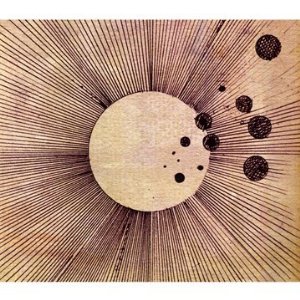Within the first seconds of “Clock Catcher,” the first song on “Cosmogramma,” it’s evident that beatmaker/composer/spaceman Flying Lotus (Stephen Ellison to his mom and dad) has left the boundaries of instrumental hip hop. The song sounds like Super Mario powering up while a Middle-Eastern orchestra tunes up in the background, all accompanied by harpist Rebekah Raff. It’s trippy, it’s disorienting, and it’s amazing.
If Ellison was referencing hip hop on his last album, 2008’s “Los Angeles,” he is using jazz as his blueprint on “Cosmogramma.” That’s not just because his cousin Ravi Coltrane plays sax on the album, or because he references Sun Ra on “Arkestry.” “Cosmogramma” is full of an intricate, controlled chaos that reminds the listener of Charles Mingus’s adventurous compositions like “Black Saint and the Sinner Lady.” There’s a lot going on in these tracks, but Ellsion holds it all together, always in control, always guiding the experience. Ellison is a composer, not a beatmaker. These songs aren’t designed merely to get people moving on a dancefloor or facilitate a drug trip. There is thought and intent and artistry behind every bloop and whirl, which includes the packaging, designed to look like some sort of astrological artifact.
He experiments with a range of sounds and genres, including dubstep (“Pickled!”), indie (“…And the World Laughs With You”), and even house (“Do the Astral Plane”). Through it all, the album maintains a consistent theme and tone, with all 17 tracks fitting together like different chapters in a story. It’s the kind of album that you have to listen to front to back, that you can’t put on shuffle, that you can’t separate out one song at a time.
Ellison is accompanied by carbon-based life forms on several songs, including bassist Thundercat, Miguel Atwood-Ferguson on strings, Ravi Coltrane on sax, and vocalists Niki Rand, Thom Yorke, and Laura Darlington. The addition of organic, analog instruments into Ellison’s digital sounds makes his music sound fuller than on past albums, giving him a wider range to work with. He even uses a ping pong ball as part of the beat on “Table Tennis.”
Ellison has described his music as “surrealist hip hop” in the past, and that label fits. It could also be described as post hip hop, music that draws upon hip hop for inspiration, but then takes it further. In that respect he’s similar to artists like J. Dilla, Madlib, and even El-P, who are grounded in hip hop but want to color outside of its guidelines, want to combine their love of jazz, soul, industrial, and electronica with hip hop’s beats and rhymes.
“Cosmogramma” is ambitious, wonky, slippery, glitchy, and beautiful. It’s Flying Lotus’ finest work to date and is one of my favorite albums of 2010 so far. Hip hop heads might be sad that Flying Lotus is no longer our little secret, but he’s too good to remain hidden in the underground.

